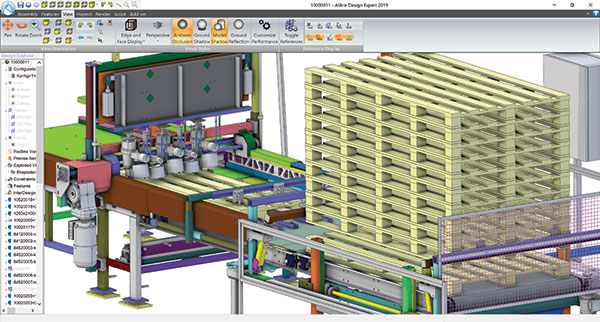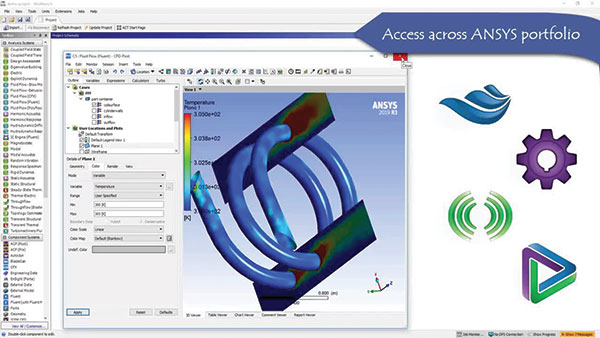New Licensing Options Satiate Users’ Appetite for Design Tool Flexibility
As the cloud gains traction and the digital business accelerates, CAD and CAE users are hungry for more flexible deployment and payment options.

Alibre is sticking with the perpetual license model for its CAD software based on customer feedback. Image courtesy of Alibre.
Latest News
December 1, 2019
For decades, design engineers have been mostly satisfied with consuming and deploying their CAD, CAE and PLM tools the traditional way: primarily on-premise, served up with a generous helping of perpetual licenses. Yet the rise of the cloud, coupled with the accelerated pace of digital transformation, have whet organizations’ appetite for a more flexible deployment palette.
Compared to mainstream enterprise software users, engineering organizations have been slower to embrace new subscription and cloud-based Software-as-a-Service (SaaS) models. Many have held off due to security concerns related to storing and managing core design intellectual property in the cloud, beyond the jurisdiction and control of engineering. Others have tread slowly due to fears about whether CAD and simulation software can run optimally in the cloud, given the bandwidth required for increasingly large and complex 3D geometries and simulation models.
Those long-standing concerns about cloud and new payment models have taken a back seat lately as organizations begin to seek more diverse offerings. Along with a hunger to integrate cloud into their enterprise architecture, many companies are re-evaluating budgetary strategies—shifting what was historically heavily weighted toward large capital expenditures to an operational expense model where assets are procured via more predictable subscription fees.
In response to shifting requirements, CAD and CAE vendors are stepping up, rolling out a smorgasbord of pay-as-you-go and hybrid deployment approaches. These offerings are designed to provide flexibility and choice during a particularly tumultuous period when businesses are grappling with unprecedented change.
“Traditionally, if you wanted to solve business problems, there was really only one way a solution could get deployed and paid for,” notes Grant Rochelle, vice president of business models & portfolio management at Siemens Digital Industries Software. “Now more than anything, we hear [customers say] we want choice. There’s not a one-size-fits-all way anymore—there’s a growing awareness that there are more ways to offer a solution to customers and more receptivity from customers as to how they want to receive software.”
Flexibility and Choice
Siemens Digital Industries Software is taking that customer feedback to heart and revamping how it offers its design and simulation application portfolio. Unlike companies like Autodesk, which now strictly delivers SaaS-based CAD, CAE and PLM tools via a subscription model, Siemens still offers the traditional perpetual license plus maintenance contract for customers that prefer that approach, but it is also serving up various new hybrid models.
For example, most applications in the Siemens portfolio are available in a subscription mode in addition to the perpetual license; however, any new software either acquired or developed internally will use subscription as the de facto model going forward, Rochelle says.
At the same time, Siemens has expanded its flexible options with managed services where customers purchase software via a perpetual license, and it is maintained by Siemens or a third party in a private cloud or delivered via “lift-and-shift” services to run in a public cloud infrastructure like Amazon Web Services. Through the Siemens online store, customers can gain access to tools like the NX Cloud Connected platform as a cloud-based subscription, including automatic updates.
Siemens also plans to break off technologies incorporated in its popular design software platforms into microservices that will be offered as cloud subscriptions and aimed at solving very specific industry problems. Currently being tested in a limited pilot program with customers, these solutions are purpose-built, cloud-native apps targeted to small and medium businesses that can be used anywhere, anytime, and will be released early next year (2020), Rochelle says.
“We’re looking at how we take the array of advanced capabilities available and bring them to market in a way that’s easy to consume and solves a very specific problem set for a particular type of customer,” he says.

ANSYS is also committed to providing choice in software licensing, especially because the industry is increasingly migrating to a hybrid model versus one specific mode of deployment, according to Steve Del, senior manager of software development at ANSYS. ANSYS lets customers choose between the traditional perpetual license for its CAE portfolio or a subscription model.
The company also offers Elastic Licensing, a flexible, pay-per-use model that enables hourly-based licensing for software, computing power and hardware. Elastic Licenses can be purchased for either existing lease or perpetual ANSYS licenses.
This piece of ANSYS’ licensing framework lets companies purchase ANSYS Elastic Units (AEUs) to meet their short-term needs for simulation resources during peak times or at the end of a cycle for a specific development project when simulation plays a much larger role. The ANSYS Elastic Units serve as prepaid tokens that are consumed based on the number of core hours used and the type of ANSYS solver in play. Rather than the three approaches being in competition, ANSYS’ strategy is to offer licensing plans that fit all types of use cases and can be mixed and matched depending on need.
“I don’t want to downplay flexibility,” Del explains. “Customers may not buy all perpetual licenses or subscription licenses—[but] depending on the particular department or job, they might choose multiple directions.”
Path to the Cloud
PTC is steering a more deliberate course to subscription pricing and SaaS. The company already made a concerted shift away from perpetual licenses to a subscription model for its applications, which can be deployed on-premise or in the cloud. Customers are gravitating toward subscription and SaaS because they want to avoid being locked in to a specific set of products and capabilities when their computing needs are in flux.
“How many times are people in a situation where they are evaluating new technology and know exactly how many seats of this software or this particular module they will need and get it right 100% of the time?” questions Bruce Reed, senior vice president of pricing and licensing at PTC. To address that issue, PTC offers a remix program as part of its subscription license that lets users shuffle around their license mix on each anniversary date.
More recently, PTC took a major step to take the lead in delivering SaaS options with its $470 million acquisition of cloud CAD provider Onshape. PTC already delivers its software running as a service in cloud. However, the current delivery model means the company runs separate systems for each customer instance, which is far less efficient compared to a true multi-tenant SaaS model, says Jim Heppelmann, PTC’s CEO. The Onshape technology provides the foundation for PTC to accelerate its move to a SaaS model, giving it economies of scale and fueling its transition to a revenue-based business model.
SaaS also offers a considerable upside for customers, Heppelmann says. With true cloud-based SaaS, customers incur less upfront cost, transfer risk back to the vendor because the service can be discontinued at any point if they’re not satisfied and achieve the flexibility to scale up or trim back service if their needs change or they are not satisfied with the software, Heppelmann says.
“We already moved to subscription to price software as a service whether we deliver it that way or not,” Heppelmann explains. “This is the next logical step.”
Although the Onshape technology will serve as the primary SaaS offering, PTC’s existing Creo and Windchill products will remain deployed either on-premise or as a service, for the foreseeable future. Eventually, Heppelmann says he sees most organizations shifting over to a SaaS model over the next decade.
“PTC knows the industry is transitioning to a SaaS model,” Heppelmann explains. “Onshape is the engine that is going to get us to the cloud. It represents, over the long run, the ‘SaaS-ification’ of PTC.”
Autodesk made an early bet on SaaS delivery and the subscription model for both its AutoCAD and Fusion 360 portfolio of CAD and simulation tools. With this, customers benefit from subscription by gaining easy access to a continuous stream of new features, including industry-specific workflows and integrated collaboration tools. They also can tap administrative tools that help control costs, allowing them to scale up or down as business cycles change, gaining insight into product usage to aid in purchase and software management decisions, according to Lauren MacLean, Business Models Manager at Autodesk.
Autodesk also has a usage-based consumption model called Token Flex, currently employed at more than 300 enterprises worldwide.
“This works like a prepaid family cellphone plan with enterprises purchasing a plan with as many ‘minutes,’ or in this [case] tokens, they need over a three-year period,” MacLean explains. Although currently a top-tier offering, Autodesk is looking to scale down the plan market to meet customer demand, according to MacLean.
Although Alibre has evaluated a switch to subscriptions, its customers prefer to stick with perpetual licenses for now, according to CEO Max Freeman. Alibre, now an independent company again after being acquired by 3D Systems, addresses flexibility around budgeting with a 10-month payment plan that gives organizations a fixed, predictable monthly cost.
“Our customers have told us in no uncertain terms that they want to own their software,” Freeman says. “A lot of things can happen—businesses can have a poor month or quarter and be down year over year. They want to be in control.”
In the end, most individual engineers are less concerned about the logistics of deploying and paying for their software and more interested in how the tools can improve their ability to build and iterate innovative products.
“Most engineers I know don’t care how software is bought and don’t have a preference for one model versus the other,” says Stan Przybylinski, vice president of CIMdata. “The model that lets them be most effective at using the software—that’s what they’ll go for.”
More Ansys Coverage
More Autodesk Coverage
More CIMdata Coverage
More PTC Coverage
Subscribe to our FREE magazine, FREE email newsletters or both!
Latest News
About the Author
Beth Stackpole is a contributing editor to Digital Engineering. Send e-mail about this article to DE-Editors@digitaleng.news.
Follow DE







